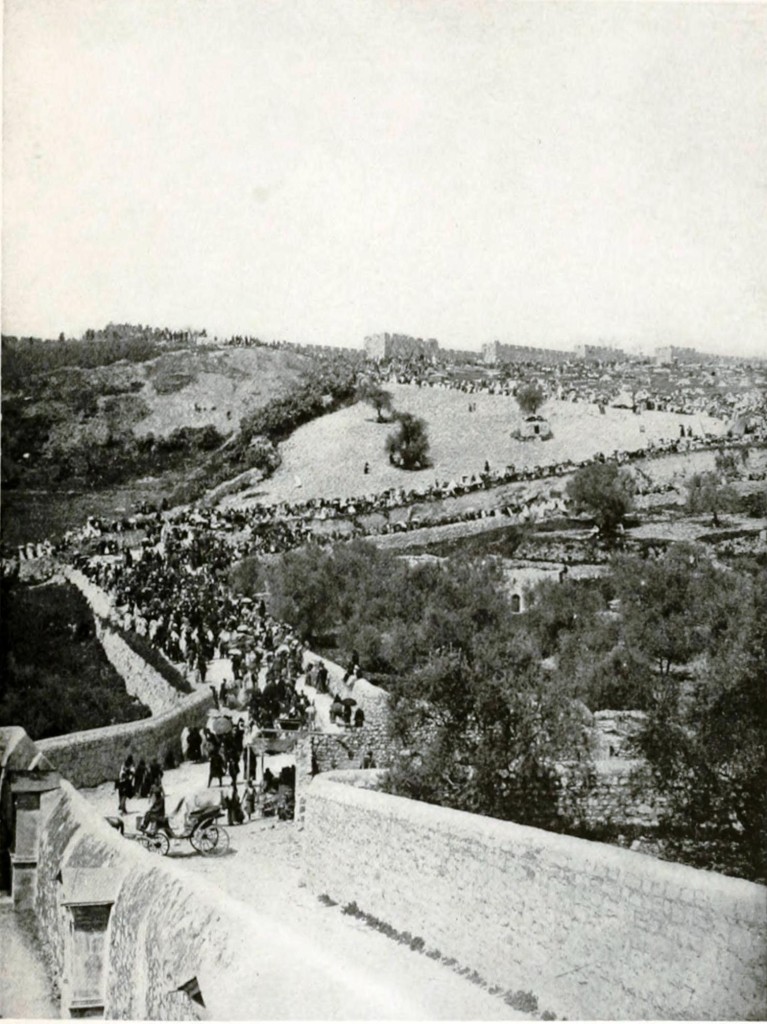Download PDF: Kaell, Notes on Pilgrimage Studies
Abstract
This article discusses some recent theoretical and methodological trends in studies of pilgrimage, a field that has grown significantly as of late. It begins by exploring how scholars might study failure during pilgrimage, and the difficulties therein. It moves on to discuss the fruitful, but also fitful, coexistence of scholars and practitioners who contribute to studies of pilgrimage. It ends by tracing some avenues for further research that would move beyond the confines of a subfield, creating the potential for work on pilgrimage to shape important conversations in multiple disciplines and areas of expertise.
I.
In 2013, I was invited to speak at a university conference affiliated with a theology department. The organizer was a thoughtful practitioner-scholar who is a pastor and adjunct faculty member, known for running a summer course in which students complete a portion of the Camino de Santiago, a 500-mile walk through Spain. The audience included many of his students and members of the public. They were mostly older, white, and (based on our subsequent conversations) Christian or “post-Christian” with a renewed sense of spirituality. As one student from his course later told me, walking the Camino was for her “an exercise in spiritual discernment.” In short, my audience took pilgrimage very seriously. They had made such journeys and believed in their power.
Not knowing much about this audience ahead of time, however, I prepared a paper titled “Can Pilgrimage Fail?”[1] It was the last piece of my five-year study of U.S. Christian trips to the Holy Land, during which time I worked with seven Catholic and Protestant groups. Drawing on this research, and particularly my pre- and post-trip interviews with more than 130 pilgrims, I argued that scholars of pilgrimage should spend more time thinking about failure. Our own failure to adequately do so seems rooted in two main issues. The first is the theoretical model inherited from Victor and Edith Turner’s classic Image and Pilgrimage in Christian Culture that contrasted pilgrimage’s transformative aspects with those of ritual initiation. Although Victor Turner argued that in Western Christianity the trip affected changes such as making one a “better person” rather than producing ritual transformation per se, the overriding assumption is nevertheless that pilgrimage does something ‘good’ in the lives of those who undertake it. Subsequent scholars have argued that it affirms salvation, reconfirms identity, provides a “ritualized break” from routine, and results in renewal or healing.[2]
Second, pilgrimage scholars face more pragmatic issues related to methodology and the sources upon which our studies often rely. We generally draw on ethnographic participation at the sites themselves or on prescriptive materials written by former pilgrims, religious leaders, and tourism bureaus. Both tend to tell us what pilgrimage ought to do, rather than what it does. At shrine sites or on the roads leading to them, we record pilgrims’ predictions about outcomes after their return, which they understandably assume (or hope) will end in success. Methodologically, it is very difficult to later trace participants who may come from widely disparate areas and coalesce for only a short period during the trip.[3] As I, and other scholars, have found, even when former pilgrims can be reached they may refuse to engage in further discussion for various reasons, including a fear of attenuating the experience.[4]
On an evangelical trip I followed in 2009, for example, I became close with Loretta, a sixty-three year old African American Methodist from South Carolina who was the only person from her church on our bus. She went alone in order to gain the personal strength to decline some of the many responsibilities she felt her family and church friends imposed upon her. She was very well liked and became integral to our group as a diffuser of conflicts and a giver of gifts and advice. A few months after our return, I visited her at home for a number of days. On the night I arrived, she cried as she told me, “I tell everybody that I went and met twenty-five angels. Everybody on that bus! I’ll always remember them even if I don’t see them again….It was nothing but angels.” Yet though Loretta felt a deep emotional attachment to the group, she found it relatively insignificant whether she actually saw any of us again and did not seek to maintain contact after our return. As I interpret her actions today, it seems that refusing continued contact may actually be an integral part of how former pilgrims extend the trip’s primary goals. For Loretta, we were “angels” because we witnessed her personal struggle and ability to overcome; she described this relationship as embodied most significantly when she was baptized alone in the Jordan, an emotional reconfirmation of her connection to Jesus that we watched and applauded from the river’s bank. And like angels’ visits, our time together relied on its fleetingness. We remained symbolically important precisely because for her we existed only in the Holy Land, unconnected to the everyday responsibilities that she sought to leave behind.[5]
Many other pilgrims do not mind continued contact with group members (including anthropologists) in the months and years after the trip. But assuming we have the means and time to visit them, we are still left with a rather large theoretical conundrum: how does one go about defining failure? Is it a kind of Geertzian meaning making, where failure is the inability to “make sense” of the journey? Is failure the gap between pre-trip goals and post-trip outcomes? Or is it something else entirely? In the conference paper I presented, I pointed out for the audience these various definitional, and to some extent practical, problems regarding the study of failure. I then turned to three examples culled from my fieldwork with a 2012 trip organized by a Christian and Missionary Alliance evangelical mega-church. In one case, a woman was praying in the Holy Land for her adult son to come to Jesus; she came home and nothing had changed. In the second case, another woman returned to find that she could not muster the words to witness to others about her experience, a serious problem since she had expected the trip would provide a way to encourage others in faith. And third, a woman came home to find herself plunged into an unprecedented “dark night of the soul” during which she lost the ability to feel God’s presence. It was the first time she had felt so alone since she was born again 35 years before.
The first two women were typical of most Christian pilgrims in my study. For them, failure was in some sense impossible. Because they couched the trip within what they viewed as the progressive trajectory of their faith lives, they were able to compel meaning making into the future: good things would happen in “God’s time,” as U.S. evangelicals often phrase it. The woman with the adult son even materialized this hope by packing away the souvenir cross she bought him, waiting for the moment when she could present it to him as a born-again believer. While my analysis pertained to evangelical Christians in particular, the wider implications concern how scholars have often conceived of pilgrimage as a single ritual act. Granted, more sophisticated studies have long understood pilgrimage as a temporally extended, flexible, and “ritual-like” experience that contains more cohesive rituals within it.[6] Nevertheless, we still neglect how pilgrimage—long before or after the journey itself—draws on or compels rituals at home that pilgrims assimilate into their memory of the experience, thereby coloring their conception of failure or success. For example, I found that former pilgrims who had been disappointed during the trip tended to frame it as successful within a few months. While this reversal may occur for a number of reasons, a key component is how they incorporated “home” rituals into what we might think of as an extensible pilgrimage experience. Post-trip actions became linked to the journey itself (and later were often narrated as such): they had finally prayed spontaneously during worship, for example, or had renewed their wedding vows. Thus a pilgrimage’s aftereffects linger into an indistinct future, a fact that is perhaps not surprising since participants are Christians, spouses, friends, or parents long before and after the journey itself.
The third case I described for my audience was different. A sense of failure was acute for the woman who lost the ability to feel God’s presence. It was a very rare experience, one of the few times I heard anything of this sort during more than five years of speaking with pilgrims.[7] Nevertheless, it was instructive because its very severity offered some basis for gauging at what point a pilgrim herself might deem the trip a failure. Importantly, she was unable to compel meaning into a future defined as ‘God’s time’ because she couldn’t feel God at all.
II.
Whisking us back to the conference in 2013, I finished my talk and waited for questions. There was just one: “Have you ever been on pilgrimage? If you had, you wouldn’t be so cynical.” For the audience, my talk on failure had, well, failed. There is surely a lesson here about knowing something of one’s audience ahead of time. However, my point also runs deeper than that. The burgeoning subfield of Pilgrimage Studies is deeply shaped by an engagement between practitioners and scholars; it informs which questions and assumptions are foregrounded or excluded. Discussing failure, for example, may be deeply problematic as a result. While this fruitful/fitful coexistence of scholars and practitioners is relevant to all branches of Religious Studies, it is especially important in Pilgrimage Studies since its resurgence in the last decade.
At one level, this close association between practitioners and scholars is to be expected, especially in work on Christianity, my field of expertise. The study of pilgrimage was greatly shaped by (even born out of) the 1978 publication of Victor and Edith Turner’s aforementioned Image and Pilgrimage in Christian Culture, a great anthropological work that dovetailed with the couple’s own conversion to Roman Catholicism. More recently, the growing interest in pilgrimage among white, middle-class North Americans and Europeans has been driving many (North American and European) scholars’ interest in the topic. The Camino de Santiago in Spain is a primary example of the rather spectacular resurgence of older pilgrimages.
The Euro/American rise in pilgrimages has drawn scholars’ attention in part because it seems to address the (supposed) anomie of post-modernity. As a recent volume puts it, “the pilgrim…represents the human being in its closest relationship with nature, something which is difficult to achieve nowadays thanks to advances in technology…For this reason walking is increasingly valued, both in its purely mechanical form…and also in its form in which the walker has a goal, we might almost say a destiny, as is the case with pilgrimages.”[8] Although this passage is framed as a general statement, the author clearly has in mind the Camino and other ‘renewed’ walking routes.
Pilgrimage’s new place of cultural prominence has also meant that more scholars (caught up in the zeitgeist) have had important personal experiences as pilgrims—often on the Camino—that have led them to undertake its study. George Greenia, director of the Institute for Pilgrimage Studies at William and Mary College, is a good example. So is Ian S. McIntosh, an Indiana University-Purdue University expert on aboriginal rights and reconciliation, who has recently begun leading interfaith walks and co-organizing an international pilgrimage conference.[9] The third such conference, “Sacred Journeys: Pilgrimages in the 21st Century,” meets in Prague in May 2016. The organizers pointedly welcome proposals from pilgrims and religious leaders and frame the main topics of discussion such that they reflect important emic assumptions related to transformation. The first topic—“Defining Pilgrimage”—begins,
‘Travel for transformation’ embraces the sacred journey as a potential turning point in one’s life. Witness the avalanche of books by pilgrims who have experienced the Camino, or those who have been influenced by the transformation of others….Questions arise as to how and when a journey becomes ‘sacred’ and how and when pilgrimage devolves into a mere tourist endeavour, and what constitutes an ‘authentic’ pilgrim…
Reflecting McIntosh’s interests, the next topic posits that pilgrimage can “Reinforc[e] the Vision of the Ultimate Unity of Humanity,” citing Greenia’s “insight that ‘pilgrimages generate the least violent mass public gatherings [that] humankind has designed for itself’…”[10] While the Sacred Journeys conference organizers may certainly be open to including a talk on failure, such language nevertheless illustrates a particular vision of Pilgrimage Studies as an interdisciplinary collaboration between practitioners and scholar-practitioners that assumes pilgrimages make something happen.[11] The people I identify loosely as “scholar-practitioners” include people of faith and tourism professionals. Both groups share a belief in the effectiveness of such journeys for ends including the management and promotion of local economies, the spiritual uplift of co-religionists, or the creation of interfaith unity and reconciliation.[12] It is in this coincidence of the practical and scholarly—where pilgrimage is instrumentalized and transformation is pitched as an ontological fact—that misjudgements or misrecognitions may arise, such as when the audience at a university conference challenges the legitimacy of a presentation on failure.
Anthropological and sociological studies of pilgrimage take a less practitioner-oriented approach (though, as Pilgrimage Studies pioneer Jill Dubisch pointed out in a recent talk, perhaps anthropologists are seduced by these journeys’ emotional, dramatic, and transformative capacities, just like pilgrims themselves).[13] Regardless, informed by the Turnerian approach and by emic understandings, scholars in this field have also viewed transformation as quasi-inherent to the experience. The journey’s transformative capacity has been one basis upon which scholars have deconstructed the category of “pilgrimage” since the early 1990s by widening it to include endeavors related to popular culture, educational trips, or “homeland” tours.[14]
III.
The 1990s was a watershed moment for Pilgrimage Studies during which conversations coalesced around a series of texts and theoretical arguments. Its rise was directly related to Western scholars’ burgeoning interest in human mobility and, more particularly, anthropologists’ experiments with moving beyond the local, bounded field site model. While most scholars in the 1990s were not insiders to pilgrimage like some of those described above, they nevertheless framed its importance based on trends within their own societies (and disciplines). As the subfield has grown in the last decade, its coming of age is marked by increased infrastructure in the form of two new book series at Ashgate and Routledge, as well as the recently established Centre for Pilgrimage Studies at York University (England) and the Institute for Pilgrimage Studies at William & Mary College (United States). Both centers are headed by a scholar of the medieval period who now also champions the study of contemporary pilgrimage.[15]
There has been some recent criticism of the field’s growing “mainstream,” especially from sociologist John Eade who has been at the forefront of pushing studies of pilgrimage in new directions, notably in his co-authored classic Contesting the Sacred (1991). His current critique relates both to the central place of Anglophone scholarship and to the concomitant importance placed on anthropological paradigms. With Italian anthropologist Dionigi Albera, Eade has recently edited a new volume that highlights the importance of ethnological studies of folklore in studies from Central and Eastern Europe.[16] While I am less bothered by anglophones or anthropology—indeed, from that perspective I am certainly part of the problem!—I agree with Eade and Albera that Pilgrimage Studies ought to pursue new directions. One way to do so is to connect our work on pilgrimage to larger questions in scholars’ respective disciplines and more broadly, in Religious Studies. Doing so helps push us beyond the synoptic vision of a “canon” and the gate-keeping institutions that concern Eade and Albera.
To my mind, some of the liveliest current conversations are those that engage ideas about ritual creativity and the secular, such as Anna Fedele’s Looking for Mary Magdalene (2012). Recent work on secularism in Religious Studies can glean much from Pilgrimage Studies, which has debated questions about space, secularity, and the sacred since the early 1990s. Ian Reader and Tony Walter’s well-known 1993 volume on popular pilgrimages, taken together with David Chidester and Edward Linenthal’s 1991 book on sacred space, has informed numerous studies that use the pilgrimage idiom to push the boundaries of what we think of as religion.[17] Pilgrimage lends itself well to such analyses since it is usually lay-centered and often takes pilgrims well beyond clearly demarcated or authorized religious zones (on the journey, if not the destination). Excellent case studies of the relationship between official and popular forms of piety have been highly developed by scholars of Islam in work on ziyara, the visits to local saints’ shrines that are under increasing attack from Islamic reformers.[18]
As Religious Studies scholar Thomas Bremer has recently noted, pilgrimage and tourism studies potentially reorient static ideas of religion even further by helpfully “setting aside lexical and intuitive (‘I know it when I see it’) definitions of religion that rely on essentialist assumptions; instead [they] highlight a more performative, constructivist view…”[19] Scholars have long used pilgrimage as a jumping off point to explore practices teetering on the edge of the secular, including motorcycle trips, the Burning Man festival, or “esoteric” journeys to New Age sites like Mount Shasta.[20] Other scholars push the idiom of pilgrimage, and thus “the sacred,” further to include visiting national parks or whitewater kayaking.[21] An especially promising line of work has been Simon Coleman’s sophisticated and ongoing theorization of pilgrimage as a “lateral” ritual, where participants both affirm and yet distance themselves from official structures. Coleman argues that pilgrimage may therefore exemplify how people in Western societies interact with religion in ways that are increasingly episodic, short, but intense.[22]
Aesthetics, value-making, and performativity also connect with economics in work on pilgrimage. In my field of American religion, this intersection is a potentially fruitful addition to a recent wave of studies about market capitalism. In my own work, for example, I explore the business of pilgrimage. More particularly, I am interested not only in how tours are structured by companies and government bodies, but in the actual moments when money changes hands in the Holy Land, as well as the discursive use of the term “commercialized” as American pilgrims seek to draw distinctions between self and other.[23] Another recent example, by social anthropologist Tea Virtanen, uses moral economy as a theoretical framework to discuss the hajj among Mbororo pastoralists in Cameroon. Cattle are a core constituent of their lives and thus of the hajj, which they make by virtue of selling their stock; indeed, Virtanen argues that Mbororo Islam inextricably incorporates cattle within it as a sign of divine blessing and a practical sacrifice on Allah’s behalf. Thus conceptualizations of pilgrimage are fundamentally linked to (moral) economic activity that is embedded within broader Mbororo understandings of the world.[24]
Studies of pilgrimage ought to move towards more sophisticated analyses of economy, as evident in Virtanen’s work. We must also recognize, to quote Bremer again, how “things deemed religious involve commodifications that are integral to the deeming process.”[25] This idea is by no means foreign to Pilgrimage Studies, which has nurtured a robust discussion about the intersection between tourism and pilgrimage over the last decade.[26] Yet we still too often reiterate projects that (explicitly or not) set up scales from sacred to secular to evaluate just how “religious” or “touristic” is any given experience. Early in my work on pilgrimage, I came to think of it as the “Susie Syndrome” based on sociologist William Swatos’ description of Clearwater, Florida, which was home in the late 1990s to a Marian apparition site and a beach. The result, writes Swatos, is a jarring, post-modern mix of sacred and secular. “Purely secular” tourists mingle with the religious and he imagines the former showing photos of the trip upon return: “Here’s Susie standing at the Mary Shrine in Clearwater. Now here’s Susie at the beach.”[27] The implication is that Susie can be classed as a secular tourist (or at least something other than a pilgrim) if she values the beach as much as the shrine.[28] Being mindful of emic notions of the authentic or spurious does not mean that we must reproduce them by referring to the economics of pilgrimage as, to quote another recent text, the unnatural “contamination” of “genuine” experience.[29]
To some degree, my concern about the tourism/pilgrimage divide brings us back to the question of failure, which likewise requires casting aside longstanding assumptions about what pilgrimage ought to do—transform, make a difference, take place at a shrine but not a beach. Scholars of pilgrimage have nuanced and destabilized the very categories of “pilgrimage” and “religion” upon which the subfield rests. They were doing so even before the genealogical turn or popular discussion of the secular within Religious Studies. In that sense, they are poised to produce potentially groundbreaking work that unearths how Western dichotomies (sacred/secular, religious/commercial) inflect studies of religion in the places or time periods where we work.[30] Moving forward, just as pilgrims’ journeys take them beyond the bounded village field site, so must we ensure that our work travels beyond the subfield called Pilgrimage Studies. Straying from this path to explore wider fields, we create the potential for work on pilgrimage to shape important conversations in our respective disciplines and areas of expertise.
Notes
[1] Subsequently published in “Ritual Risk and Emergent Efficacy: Ethnographic Studies in Christian Ritual,” a special issue of the Journal of Contemporary Religion forthcoming in October 2016.
[2] Victor Turner, “Death and the Dead in the Pilgrimage Process,” Ed. Edith Turner. Blazing the Trail (Tucson: Arizona University Press, 1992) 37; Victor and Edith Turner, Image and Pilgrimage in Christian Culture (New York: Columbia University Press, 1978) 34–35; Alan Morinis, ed. Sacred Journeys: The Anthropology of Pilgrimage (Westport: Greenwood Press, 1992), 27; Nelson Graburn, “Tourism: The Sacred Journey.” Ed. Valene Smith. Hosts and Guests: The Anthropology of Tourism, 21-36 (Philadelphia: University of Pennsylvania Press, 1977), 22; Jill Dubisch and Mark Winkelman. “Introduction.” Pilgrimage and Healing. Tucson: University of Arizona Press, 2005.
[3] Simon Coleman, “Do you believe in pilgrimage? Communitas, Contestation and Beyond,” Anthropological Theory 2 (2002): 355-68. See page 358. There are some exceptions that did follow up with pilgrims after the trip, at least by trading some letters, including Anna Fedele, Looking for Mary Magdalene: Alternative Pilgrimage and Ritual Creativity at Catholic Shrines in France (Oxford University Press, 2012) and Nancy Frey, Pilgrim Stories: On and Off the Road to Santiago, Journeys Along an Ancient Way in Modern Spain (Berkeley: University of California Press, 1998). Fewer still have also worked with pilgrims before departure.
[4] Frey, Pilgrim Stories, 191.
[5] I tell this story in more detail in Walking Where Jesus Walked: American Christians and Holy Land Pilgrimage (New York University Press 2014), 170-175.
[6] Catherine Bell, Ritual: Perspectives and Dimensions [1997] (New York: Oxford University Press, 2009), x, 102, 248.
[7] I should note that it is very difficult to gauge how often this situation occurs since former pilgrims who experience a sense of failure may opt out of post-trip interviews. When people opted out, it was usually through their silence and I never knew why.
[8] Antón M. Pazos, Pilgrims and Pilgrimages as Peacemakers in Christianity, Judaism and Islam (Farnham, UK: Ashgate 2013), 1-2.
[9] Kanwal Prakash Singh, “A Modern-Day Pilgrimage: The Interfaith Walk in Indianapolis,” Sikhchic.com, 30 October 2012. Accessed 12 November 2015. https://sikhchic.com/current_events/a_modernday_pilgrimage_the_interfaith_walk_in_indianapolis
[10] Ian McIntosh and Rob Fisher, “Sacred Journeys: Pilgrimages in the 21st Century, 3rd Global Meeting: Call for Participation 2016” Inter-Disciplinary.net, Accessed 12 November 2015. http://www.inter-disciplinary.net/probing-the-boundaries/persons/sacred-journeys/call-for-presentations/
There is a stream of social scientific work on pilgrimage that also focuses on interfaith relations. See for example Glenn Bowman, ed. Sharing the sacra: the politics and pragmatics of inter-communal relations around holy places (London: Berghahn Books, 2012).
[11] In Europe and Israel, the two areas beyond North America with which I have some familiarity, more universities maintain departments of tourism studies. Scholars in this field often work closely with government or local stakeholders to address the challenges of ‘managing’ sacred sites. Their goals may include trying to learn how to encourage pilgrimage and make it more profitable (monetarily, ideologically, etc.).
[12] Cf. Simon Coleman, “The Janus Face of Pilgrimage,” in Pazos, ed. Pilgrims and Pilgrimages as Peacemakers in Christianity, Judaism and Islam (Farnham, UK: Ashgate 2013). Publications about marketing and managing pilgrimage are too numerous to detail here and not my own area of expertise. Such studies are especially prevalent among researchers working in business management, often outside of Europe and North America. They are not generally in conversation with scholars grouped ‘Pilgrimage Studies.’ Typical recent examples include Farooq Haq and Ho Yin Wong, “Branding Islamic Spiritual Tourism: An Exploratory Study in Australia and Pakistan” European Journal of Business and Management 5:11 (2013) 154-162; Jabil Mapjabil et. al., “Islamic tourism: a conceptual review and its relevance in Malaysia,” Geografia. Malaysian Journal of Society and Space, 11:1 (2015) 172-182.
[13] Jill Dubisch, “The Seduction of the Anthropologist,” American Anthropological Association Annual Meeting (Denver, Colorado), 20 November 2015.
[14] E.g. Jackie Feldman. Above the Death Pits, Beneath the Flag: Youth Voyages to Poland and the Performance of Israeli National Identity. New York: Berghahn Books, 2010.
[15] I am referring to George Greenia at William and Mary and Dee Dyas at York.
[16] Dionigi Albera and John Eade, “International Perspectives on Pilgrimage Research” Eds. Albera and Eade. International Perspectives on Pilgrimage Studies. London: Routledge 2015) 1-22.
[17] Ian Reader and Tony Walter, Pilgrimage in Popular Culture (London: Macmillan Press, 1993);
David Chidester and Edward T. Linenthal, eds. American Sacred Space. Bloomington: Indiana University Press, 1995.
[18] E.g. Ismail Fajrie Alatas, “Pilgrimage and Network Formation in Two Contemporary Ba ‘Alawi Hawl in Central Java,” Journal of Islamic Studies 25:3 (2014) pp. 298–324.
[19] Thomas S. Bremer, “Touristic Angle of Vision: Tourist Studies as a Methodological Approach for the Study of Religions,” Religion Compass 8:12 (2014) 371-79. See page 374.
[20] Rooted in nineteenth-century Transcendentalism and Romanticism, as well as the twentieth-century Beat movement, outdoor, nature-based journeys are integral to the New Age movement today. Besides Fedele, Looking for Mary Magdalene, see also Madeline Duntley, “Spiritual tourism and frontier esotericism at Mount Shasta, California,” International Journal for the Study of New Religions, 5: 2 (2014) 123-150; Lee Gilmore, Theater in a Crowded Fire: Ritual and Spirituality at Burning Man (Berkeley: University of California Press, 2010), Raymond J. Michalowski and Jill Dubisch Run for the Wall: Remembering Vietnam on a Motorcycle Pilgrimage (New Brunswick: Rutgers University Press, 2001)
[21] Lynn Ross-Bryant, “Sacred Sites: Nature and Nation in the U.S. National Parks,” Religion and American Culture 15:1 (2005) 31-62; A Whitney Sanford, “Pinned on Karma Rock,” Journal of the American Academy of Religion, 75:4 (2007), 875-895.
[22] Simon Coleman, “On Mirrors, Masks and Traps: Ambiguity, Risk and ‘Lateral Participation’ in Ritual” Journal of Ritual Studies 23:2 (2009): 43–52; Coleman, “Purity As Danger? Seduction, Sexuality and Slipperiness in Christian Pilgrimage,” American Anthropological Association Annual Meeting (Denver, Colorado), 20 November 2015.
[23] Some of that material is summarized in Kaell, “Commerce, Commercialism, Commercialization: How Money Gets Spent and Talked About on Holy Land Tours,” Sacred Matters, January 2015. See also Kaell, Walking Where Jesus Walked.
[24] Tea Virtanen, “Transforming Cattle into Blessings: The Moral Economy of Mhororo Pilgrimage,” Journal of Religion in Africa, 44 (2014) 92-126. She draws on Jonathan Parry and Maurice Bloch, ‘Introduction: Money and the Morality of Exchange’. In Parry and Bloch (eds.). Money and the Morality of Exchange. Cambridge: Cambridge University Press, 1989), 1-32.
[25] Bremer, “Touristic Angle of Vision,” 377.
[26] Ellen Badone and Sharon R. Roseman. Intersecting Journeys: The Anthropology of Pilgrimage and Tourism. Chicago: University of Illinois Press, 2004; William H. Swatos, Jr. ed. On the Road to Being There: Studies in Pilgrimage and Tourism in Late Modernity Leiden and Boston: Brill Publishers, 2006.
More recently, Michael Stausberg’s Religion and Tourism: Crossroads, Destinations, and Encounters (London: Routledge, 2011) which sets out to challenge the sacred versus secular dichotomy in religious studies that regards religion and tourism as mutually exclusive phenomena.
[27] William Swatos Jr. “Our Lady of Clearwater: Postmodern Traditionalism” in William Swatos and Luigi Tomasi, eds. From Medieval Pilgrimage to Religious Tourism (New York: Praeger 2002) 191.
[28] A comparison could be drawn between my use of “Susie Syndrome” and Robert Bellah’s well-known “Sheila-ism.” Trenchant criticism of Bellah has come from feminist scholars who reject his understanding of Sheila as self-absorbed and argue that this is the result of a male-centered narrative where women, like Sheila, have had to find religious fulfillment in their own “little voices.” Although Swatos undoubtedly did not mean to make a comment about women’s religious behaviors, choosing a “Susie” instead of a “Steven” is nevertheless noteworthy.
[29] Pazos, Pilgrims and Pilgrimages, 3 and note 5.
[30] P. J. Johnston, “Dharma Bums: The Beat Generation and the Making of Countercultural Pilgrimage,” Buddhist-Christian Studies 33 (2013) 165–179. See page 176.






